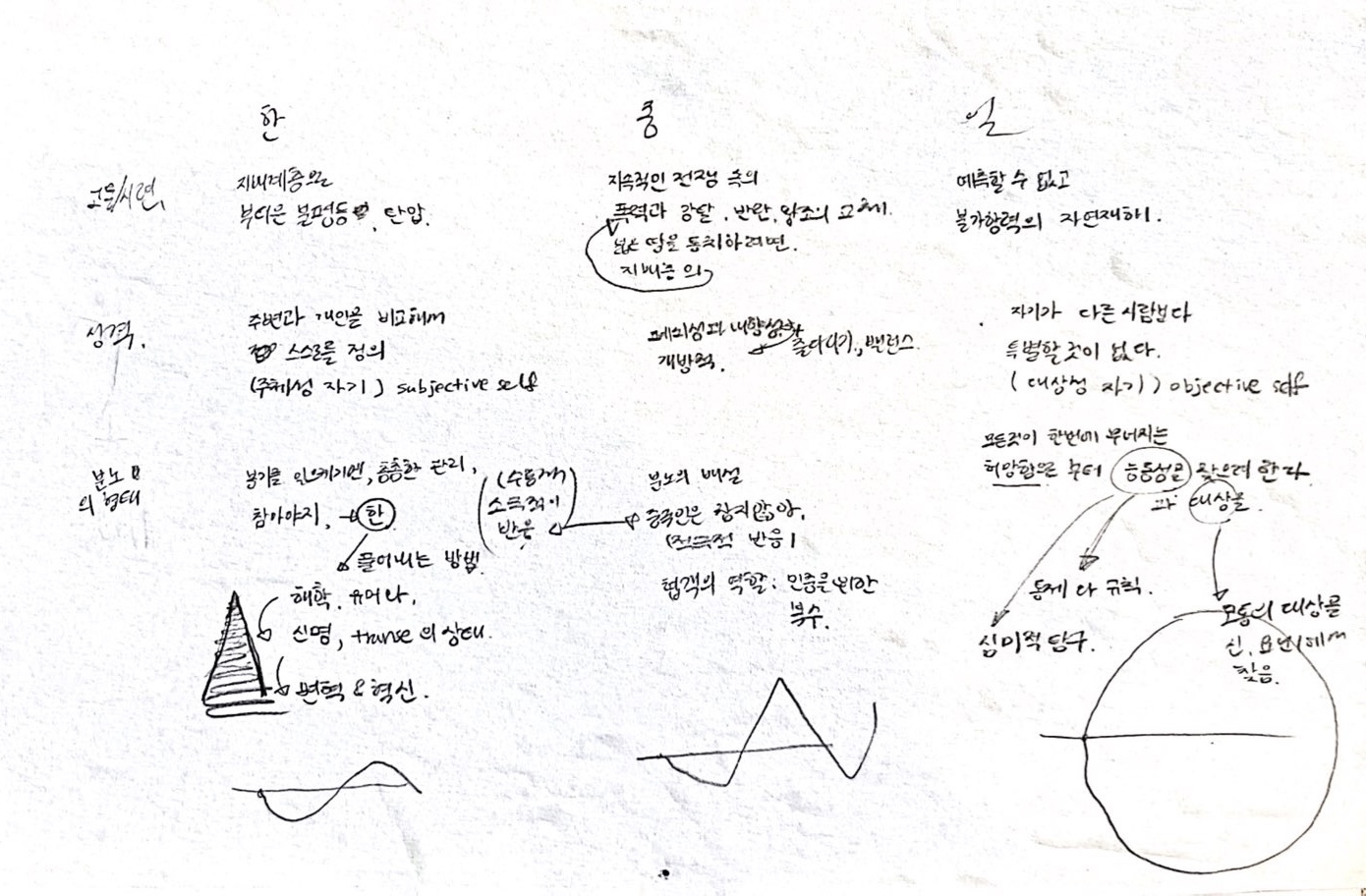[ People Shook or Shaken or Not Shaken ]
29 July 2023
As I stayed abroad since young, I missed out on details of East Asian history. I needed to know the differences of inner characteristics of the three East Asian countries in order to confidently say “ I’m not Chinese”. This story is about the nature of people formed by overcoming their own ordeals in three closely related but distinctive countries.
The Koreans shook themselves. With tight supervision in a small land, ordinary people shook their bodies and heads before shaking the society. When the sadness of people is suppressed, it upgrades into something called Han (한). This anguish spirit had no place to go but into humble humors among the people with passive nature. Still, if the spirit is not comforted enough, they looked for something called Sinmyung (신명), best translated as an intense status of focus, pleasure, trance. If it is still not resolved, then it bursts into uprising at the end, after all these steps.
On the other hand, the shaken are the Chinese. Unlike Koreans, they were frank about their anger and release directly. During the continuous violence and extortion between countless kingdoms and tribes on the vast land, they learned to actively respond to the suffering.
While Korean and Chinese people could identify the source of anger due to the pressure and aggression from the ruling class and outside forces, Japan suffered from unexpected natural disasters. The people couldn’t blame anything but the sky. Piles of efforts and fortunes were destroyed. When recovered, again crushed by another random force. To resist helpless circumstances, They developed an obsession for control and proactivity. Lunch box had to be neatly cute and delicate even if it will be eaten soon and it was necessary to produce an aesthetically unique shape for the shooting window of a rampart. In search of beauty, they redeemed themselves. The Japanese were not shaken and firmly showed the stance of “nevertheless”, living on the swaying ground.
It is too brief to conclude that Japanese culture is the culture of death. Even though it seems to praise death on the outside, if they truly praise death, how will the culture be prolonged? If “Praise of Death” is put into the inner-mind translator, it would be a cry of “I’m afraid of death.” says Sang Hyun Ji, the author of Antagonism -The Cultural Psychology of Korean, China and Japan.
As I jumped around the chapters of the book, Antagonism, I took notes of the anger management approaches which were the background of the culture of three countries. And at the end, I drew graphs, based on the author’s words, of each country’s rhythm with the energy of yin and yang. I found a circle in one of the three.
![]()
29 July 2023
As I stayed abroad since young, I missed out on details of East Asian history. I needed to know the differences of inner characteristics of the three East Asian countries in order to confidently say “ I’m not Chinese”. This story is about the nature of people formed by overcoming their own ordeals in three closely related but distinctive countries.
The Koreans shook themselves. With tight supervision in a small land, ordinary people shook their bodies and heads before shaking the society. When the sadness of people is suppressed, it upgrades into something called Han (한). This anguish spirit had no place to go but into humble humors among the people with passive nature. Still, if the spirit is not comforted enough, they looked for something called Sinmyung (신명), best translated as an intense status of focus, pleasure, trance. If it is still not resolved, then it bursts into uprising at the end, after all these steps.
On the other hand, the shaken are the Chinese. Unlike Koreans, they were frank about their anger and release directly. During the continuous violence and extortion between countless kingdoms and tribes on the vast land, they learned to actively respond to the suffering.
While Korean and Chinese people could identify the source of anger due to the pressure and aggression from the ruling class and outside forces, Japan suffered from unexpected natural disasters. The people couldn’t blame anything but the sky. Piles of efforts and fortunes were destroyed. When recovered, again crushed by another random force. To resist helpless circumstances, They developed an obsession for control and proactivity. Lunch box had to be neatly cute and delicate even if it will be eaten soon and it was necessary to produce an aesthetically unique shape for the shooting window of a rampart. In search of beauty, they redeemed themselves. The Japanese were not shaken and firmly showed the stance of “nevertheless”, living on the swaying ground.
It is too brief to conclude that Japanese culture is the culture of death. Even though it seems to praise death on the outside, if they truly praise death, how will the culture be prolonged? If “Praise of Death” is put into the inner-mind translator, it would be a cry of “I’m afraid of death.” says Sang Hyun Ji, the author of Antagonism -The Cultural Psychology of Korean, China and Japan.
As I jumped around the chapters of the book, Antagonism, I took notes of the anger management approaches which were the background of the culture of three countries. And at the end, I drew graphs, based on the author’s words, of each country’s rhythm with the energy of yin and yang. I found a circle in one of the three.
